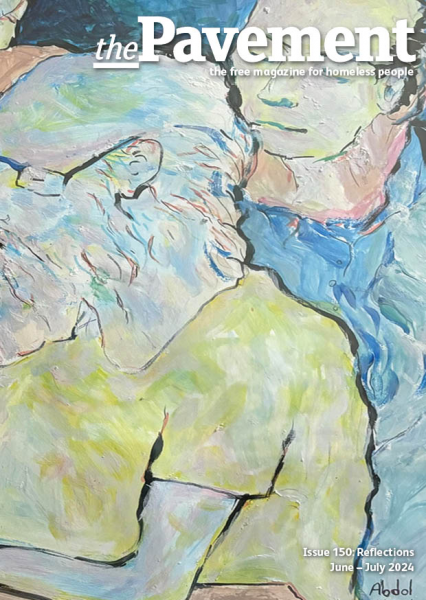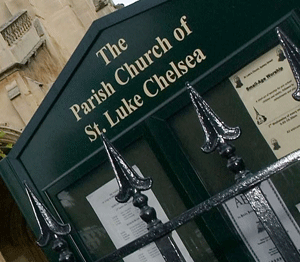
Established 2005 Registered Charity No. 1110656
Scottish Charity Register No. SC043760
DONATE
Please help us to help more homeless people by setting up a monthly direct debit.
the Pavement relies on donations and volunteering from individuals and companies...
MORE ON DONATING
RECENT TWEETS
Church move-on was an exercise in displacement, resettlement figures suggest
St Luke's in Chelsea has become the latest London Church to remove rough sleepers from its grounds. On 3rd August, a letter from the Reverend Joe Moffatt was left for those sleeping rough on its porch informing them that the church is "withdrawing permission for anyone to sleep on its premises."
An increase in rough sleepers within church grounds and a shift towards using the church as a "permanent place of choice, than as a last resort" had forced the church to change its policy, the letter said. It also said that, "this is not appropriate either for the individuals concerned or for the church as a sacred space in the community."
Those using the church as a refuge have been invited to attend a surgery to help them find alternative arrangements, but for some, this is their second move-on from church grounds in less than 18 months.
In February 2005, rough sleepers were moved off the steps of the Parish Church of St Marylebone as part of plans to target homeless 'hotspots.' The Pavement covered the action after a letter from a reader, Steve, detailed what happened. A copy of the eviction letter was given to the rough sleepers by the vicar on St Valentine's Day.
As another set of rough sleepers is moved on, what has happened to those evicted from Marylebone and is the move-on policy proving effective?
When Marylebone Church decided to issue the eviction notice to those on its steps, it was part of a move to remove the sleepers from its land, alongside an effort by outreach workers to offer accommodation to all those present. But the results suggest that it was less of a success in getting people into hostels and more an exercise in displacement.
The Pavement caught up with Steve and Marylebone Joe, both of whom were present during the Marylebone move-on. Joe thought that there had been around 17 sleeping on site and that after the action nine were still on the street, two had disappeared and only six were in temporary accommodation. Steve told us "there was a core of about eight of us." Of these, he thought that five were still on the street, one in a rolling shelter and two in hostels.
A spokesman for Westminster Council said: "As far as we are aware, of those moved on from Marylebone Church last year, one person has moved out of the area, one is in a hostel, one has moved into a shared house, and three are still on the streets." Despite the varying figures, all collected in May, the results are not good enough to justify the disruption caused, and should provide evidence for a review of the policy. "I don't think they thought beyond the rolling shelters," Steve said.
What was particularly sad in these cases are that they are occurring on the grounds of a Church. Contrast nearby Hinde Street Methodist Church, which was also asked to consider moving on those sleeping on its steps.
Father Leao Neto spoke to the The Pavement to clarify the situation, saying that [the Church Council] had decided to "allow people on the steps, not because it is a solution, but because if they want to move on [in life] we're ready for them."
His practical Christianity is demonstrated by his tolerance of some street drinkers, who also used the Church grounds, with his simple message: "We're here for you, if you want to change." He refused to comment on the attitude of St Marylebone Parish Church and The Pavement has, despite many messages to the church and to the Bishop, received no comment of regret from those involved in this action.
The Bishop of Kensington, The Right Reverend Michael Colclough, told us that the move-on had "been a success in finding flats or hostel accommodation for people who were previously sleeping on the street." He cited no figures, however, and perhaps was not aware of the true numbers, but he also refused to be drawn on whether they had followed up on what had happened to those who didn't go into hostels.
Indeed no one, either from the Church, the council or the outreach teams appears to have gone back to consider the statistics after the move, and whether it is helpful to their published goals to move people on in this manner.
When we asked St Marylebone Parish Church to comment on their part in targeting a 'hotspot' we eventually received an email from the parish secretary stating "St Marylebone Parish Church has no comment to make on this matter."
Of course, the Church has a long history of giving shelter and succour to the homeless. Many organisations have their roots in the activities of particular churches, and many continue to practice what they preach. However, here the Church has failed to act in line with its own teachings, and the latest move-on suggests that a review of the policy is not in sight.
June – July 2024 : Reflections
CONTENTS
BACK ISSUES
- Issue 150 : June – July 2024 : Reflections
- Issue 149 : April – May 2024 : Compassion
- Issue 148 : February – March 2024 : The little things
- Issue 147 : December 2023 – January 2024 : Next steps
- Issue 146 : October 2023 – November 2023 : Kind acts
- Issue 145 : August 2023 – September 2023 : Mental health
- Issue 144 : June 2023 – July 2023 : Community
- Issue 143 : April 2023 - May 2023 : Hope springs
- Issue 142 : February 2023 - March 2023 : New Beginnings
- Issue 141 : December 2022 - January 2023 : Winter Homeless
- Issue 140 : October - November 2022 : Resolve
- Issue 139 : August - September 2022 : Creativity
- Issue 138 : June - July 2022 : Practical advice
- Issue 137 : April - May 2022 : Connection
- Issue 136 : February - March 2022 : RESPECT
- Issue 135 : Dec 2021 - Jan 2022 : OPPORTUNITY
- Issue 134 : September-October 2021 : Losses and gains
- Issue 133 : July-August 2021 : Know Your Rights
- Issue 132 : May-June 2021 : Access to Healthcare
- Issue 131 : Mar-Apr 2021 : SOLUTIONS
- Issue 130 : Jan-Feb 2021 : CHANGE
- Issue 129 : Nov-Dec 2020 : UNBELIEVABLE
- Issue 128 : Sep-Oct 2020 : COPING
- Issue 127 : Jul-Aug 2020 : HOPE
- Issue 126 : Health & Wellbeing in a Crisis
- Issue 125 : Mar-Apr 2020 : MOVING ON
- Issue 124 : Jan-Feb 2020 : STREET FOOD
- Issue 123 : Nov-Dec 2019 : HOSTELS
- Issue 122 : Sep 2019 : DEATH ON THE STREETS
- Issue 121 : July-Aug 2019 : INVISIBLE YOUTH
- Issue 120 : May-June 2019 : RECOVERY
- Issue 119 : Mar-Apr 2019 : WELLBEING
- Issue 118 : Jan-Feb 2019 : WORKING HOMELESS
- Issue 117 : Nov-Dec 2018 : HER STORY
- Issue 116 : Sept-Oct 2018 : TOILET TALK
- Issue 115 : July-Aug 2018 : HIDDEN HOMELESS
- Issue 114 : May-Jun 2018 : REBUILD YOUR LIFE
- Issue 113 : Mar–Apr 2018 : REMEMBRANCE
- Issue 112 : Jan-Feb 2018
- Issue 111 : Nov-Dec 2017
- Issue 110 : Sept-Oct 2017
- Issue 109 : July-Aug 2017
- Issue 108 : Apr-May 2017
- Issue 107 : Feb-Mar 2017
- Issue 106 : Dec 2016 - Jan 2017
- Issue 105 : Oct-Nov 2016
- Issue 104 : Aug-Sept 2016
- Issue 103 : May-June 2016
- Issue 102 : Mar-Apr 2016
- Issue 101 : Jan-Feb 2016
- Issue 100 : Nov-Dec 2015
- Issue 99 : Sept-Oct 2015
- Issue 98 : July-Aug 2015
- Issue 97 : May-Jun 2015
- Issue 96 : April 2015 [Mini Issue]
- Issue 95 : March 2015
- Issue 94 : February 2015
- Issue 93 : December 2014
- Issue 92 : November 2014
- Issue 91 : October 2014
- Issue 90 : September 2014
- Issue 89 : July 2014
- Issue 88 : June 2014
- Issue 87 : May 2014
- Issue 86 : April 2014
- Issue 85 : March 2014
- Issue 84 : February 2014
- Issue 83 : December 2013
- Issue 82 : November 2013
- Issue 81 : October 2013
- Issue 80 : September 2013
- Issue 79 : June 2013
- Issue 78 : 78
- Issue 77 : 77
- Issue 76 : 76
- Issue 75 : 75
- Issue 74 : 74
- Issue 73 : 73
- Issue 72 : 72
- Issue 71 : 71
- Issue 70 : 70
- Issue 69 : 69
- Issue 68 : 68
- Issue 67 : 67
- Issue 66 : 66
- Issue 65 : 65
- Issue 64 : 64
- Issue 63 : 63
- Issue 62 : 62
- Issue 61 : 61
- Issue 60 : 60
- Issue 59 : 59
- Issue 58 : 58
- Issue 57 : 57
- Issue 56 : 56
- Issue 56 : 56
- Issue 55 : 55
- Issue 54 : 54
- Issue 53 : 53
- Issue 52 : 52
- Issue 51 : 51
- Issue 50 : 50
- Issue 49 : 49
- Issue 48 : 48
- Issue 47 : 47
- Issue 46 : 46
- Issue 45 : 45
- Issue 44 : 44
- Issue 43 : 43
- Issue 42 : 42
- Issue 5 : 05
- Issue 4 : 04
- Issue 2 : 02
- Issue 1 : 01
- Issue 41 : 41
- Issue 40 : 40
- Issue 39 : 39
- Issue 38 : 38
- Issue 37 : 37
- Issue 36 : 36
- Issue 35 : 35
- Issue 34 : 34
- Issue 33 : 33
- Issue 10 : 10
- Issue 9 : 09
- Issue 6 : 06
- Issue 3 : 03
- Issue 32 : 32
- Issue 31 : 31
- Issue 30 : 30
- Issue 29 : 29
- Issue 11 : 11
- Issue 12 : 12
- Issue 13 : 13
- Issue 14 : 14
- Issue 15 : 15
- Issue 16 : 16
- Issue 17 : 17
- Issue 18 : 18
- Issue 19 : 19
- Issue 20 : 20
- Issue 21 : 21
- Issue 22 : 22
- Issue 23 : 23
- Issue 24 : 24
- Issue 25 : 25
- Issue 8 : 08
- Issue 7 : 07
- Issue 26 : 26
- Issue 27 : 27
- Issue 28 : 28
- Issue 1 : 01

